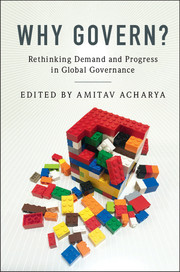Book contents
- Frontmatter
- Contents
- List of Figures
- List of Tables
- Notes on Contributors
- Acknowledgments
- List of Abbreviations
- 1 Rethinking Demand, Purpose and Progress in Global Governance: An Introduction
- Part I The Changing Concept of Global Governance
- Part II Issue Areas
- 5 Conflicts and Security
- 6 Human Rights
- 7 Atrocity Crimes
- 8 Trade
- 9 Finance
- 10 Climate
- 11 Refugees
- 12 Health
- 13 Cyberspace and Social Media
- 14 The Contested Quest for Global Governance: Conclusions and Directions for Further Research
- Bibliography
- Index
13 - Cyberspace and Social Media
from Part II - Issue Areas
Published online by Cambridge University Press: 05 September 2016
- Frontmatter
- Contents
- List of Figures
- List of Tables
- Notes on Contributors
- Acknowledgments
- List of Abbreviations
- 1 Rethinking Demand, Purpose and Progress in Global Governance: An Introduction
- Part I The Changing Concept of Global Governance
- Part II Issue Areas
- 5 Conflicts and Security
- 6 Human Rights
- 7 Atrocity Crimes
- 8 Trade
- 9 Finance
- 10 Climate
- 11 Refugees
- 12 Health
- 13 Cyberspace and Social Media
- 14 The Contested Quest for Global Governance: Conclusions and Directions for Further Research
- Bibliography
- Index
Summary
Introduction
Cyberspace is a term that emerged in 1980s science fiction, and in popular culture in the 1990s. The term “cyberspace” generally refers to all of the spaces online that use the Internet, over fixed and mobile communication networks, including the World Wide Web and all the popular social media and other applications that use this infrastructure. There is an even broader conception known as the “Information Society,” which includes an understanding of the ways in which communities and countries around the world use cyberspace for social, political and economic goals and how these societies are being shaped and reshaped by the uses of information and communications technologies. In this chapter, while we will make references to these broader constructions, we will focus specifically on Internet governance. This focus enables us to carefully specify the institutions and individuals that are involved in the norm creation and decision-making processes, as well as the enforcement mechanisms that allow the Internet to operate as a globally distributed “network of networks,” which allows social media and all of cyberspace to exist. Even this narrow focus is difficult. We get pulled between the highly technical and specific aspects of developing software and hardware protocols; and the broader policy-oriented aspects of managing the scarce resources related to the Internet and its numerous applications and their implications.
The Internet as we know it today, emerged in the 1980s out of earlier networking technologies, such as the Advanced Research Projects Agency Network (ARPANET) in the late 1960s. When the Internet was first developed, only a small handful of computer scientists, technology experts and government officials even knew about it, much less how to use this new technology. Over the years, use of the Internet continued to grow at a relatively slow pace, and in 1995, there were an estimated 16 million Internet users worldwide. But over the past two decades, the number of Internet users has increased dramatically, with an estimated 3.4 billion users worldwide in 2015, representing 46.4 percent of the global population. The highest Internet penetration rates are in North America (87.9 percent), with Europe (73.5 percent) and Oceania/Australia (73.2 percent) following closely behind.
- Type
- Chapter
- Information
- Why Govern?Rethinking Demand and Progress in Global Governance, pp. 252 - 271Publisher: Cambridge University PressPrint publication year: 2016
- 2
- Cited by



